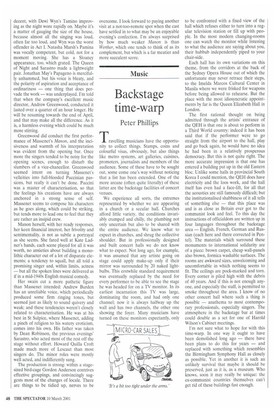Music
Backstage time-warp
Peter Phillips
Travelling musicians have the opportunity to collect things. Stamps, coins and colourful visas, obviously, but also things like metro systems. art galleries, cuisines, promoters, journalists and members of the audience. Some of these have to be sought out, some come one's way without noticing that a list has been extended. One of the more arcane (often quite literally) of these latter are the backstage facilities of concert venues.
We experience all sorts, the extremes represented by whether we are appearing in a church or a secular hall. Churches afford little variety, the conditions invariably cramped and chilly, the plumbing not only uncertain but also to be shared with the entire audience. We know what to expect in churches, and shrug the collective shoulder. But in professionally designed and built concert halls we do not know what to expect. Not long ago, for example, it was assumed that any artiste going on stage could apply make-up only if their mirror was surrounded by 20 naked lightbulbs. This erstwhile standard requirement was eventually replaced by the need for every performer to be able to see the stage he was headed for on a TV monitor. In its earliest incarnation this TV was large, dominating the room, and had only one channel; now it is always halfway up the wall and has two channels, the other one showing the foyer. Many musicians have turned on these monitors expectantly, only
to be confronted with a fixed view of the hall which refuses either to turn into a regular television station or fill up with people. In the most modern changing-rooms one can watch the monitor while listening to what the audience are saying about you, their hubbub independently piped to your chair-side.
Each hall has its own variations on this theme, from the corridors at the back of the Sydney Opera House out of which the unfortunate may never retrace their steps, to the Imelda Marcos Cultural Center in Manila where we were frisked for weapons before being allowed to rehearse. But the place with the most idiosyncratic appointments by far is the Queen Elizabeth Hall in London.
The first rational thought on being admitted through the artists' entrance of the QEH is that one is about to perform in a Third World country: indeed it has been said that if the performer were to go straight from the airport to the hall, play and go back again, he would have no idea he had been in a relatively prosperous democracy. But this is not quite right. The more accurate impression is that one has entered a building put up in the old Eastern bloc. Unlike some halls in provincial South Korea I could mention, the QEH does have electricity and the loos work, and the hall itself has even had a face-lift, for all that the acoustics are still famously difficult; but the institutionalised shabbiness of it all tells of something else — that this place was and is as close as Britain ever got to the communist look and feel. To this day the instructions of officialdom are written up in four languages throughout the backstage area — English, French, German and Russian (each here and there corrected in Pentel). The materials which surround these monuments to international solidarity are of a piece: brown carpet, cheap wall-panels also brown, formica washable surfaces. The rooms are awkward sizes, unwelcoming and uncomfortable in which nothing seems to fit. The ceilings are pock-marked and torn. Every corner is piled high with the debris of 40 years. And if this is not enough anyone, and especially the staff, is permitted to smoke throughout the area. I know of no other concert hall where such a thing is possible — anathema to most contemporary professionals, especially singers. The atmosphere in the backstage bar at times could double as a set for one of Harold Wilson's Cabinet meetings.
I'm not sure what to hope for with this time-warp. In one way it ought to have been demolished long ago — there have been plans to do this for years — and replaced with something which resembles the Birmingham Symphony Hall as closely as possible. Yet in another it is such an unlikely survival that maybe it should be preserved, just as it is, as a museum. Who knows, soon it may really be unique: the ex-communist countries themselves can't get rid of these buildings fast enough.


































































 Previous page
Previous page